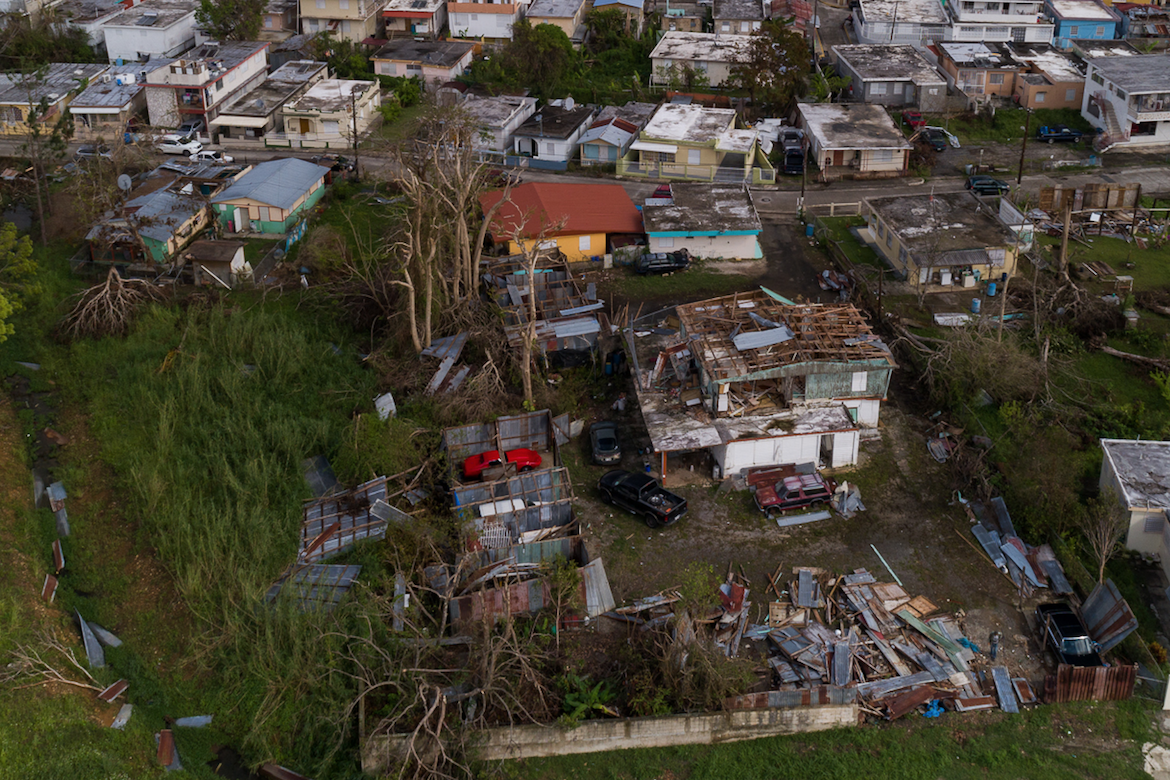When the eye of Hurricane María entered Puerto Rico through his town, Mayor Jorge Márquez thought the worst was over. Minutes later, the toughest part began.
When the hurricane’s rotation shifted, it struck harder and tore off the door of his in-law’s home, where all of his family had decided to await what would be the worst storm to tear through the island in nearly a century. The panicked grandchildren and women ran to take shelter in a bedroom. And he and the other men grabbed the dining room table, put it in the gap that was left, and spent the next four hours pushing it against the fury of the 155-mph winds.
Once the gusts subsided, he was able to go out into the street to see the damage. And he was only able to cry.
“Everything we’ve built over 16 years, destroyed in a single day,” he said Tuesday, pausing to fight back fresh tears.
On September 20, María took down all the trees and power cables, much of his government’s structures, including the Diagnostic and Treatment Center, the town’s only hospital, and even the funeral home. It also tore the roof off of more than 700 houses of the town’s 12,000 residents.
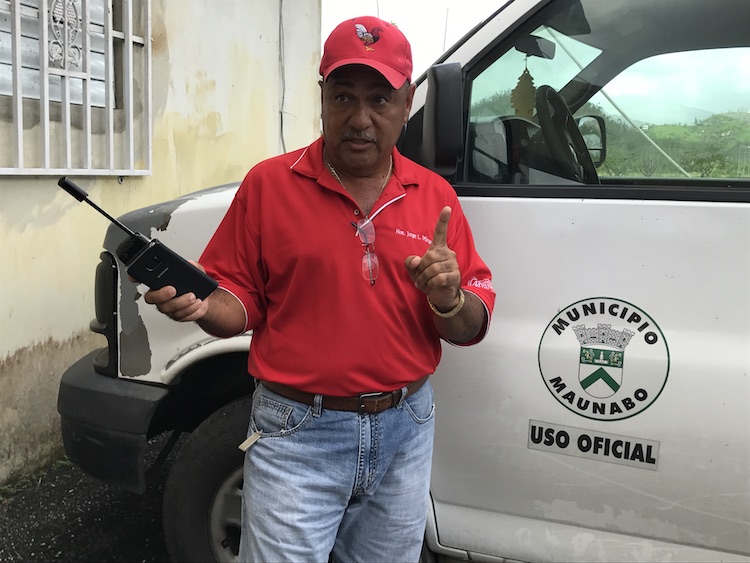
Centro de Periodismo Investigativo
Maunabo’s Mayor Jorge Márquez
A month after the storm made landfall, Maunabo has only received 58 tarps from FEMA.
Neither Gov. Ricardo Rosselló nor any of the heads of the government’s 131 agencies have visited, he said. The have not called him either.
Friday marked 30 days of Puerto Rico’s ongoing crisis after Hurricane María’s devastation, and the government at all levels — federal, state and municipal — continue putting out fires on a daily basis to address the most basic needs: water, food, and saving lives and property.
The permanent disaster has been largely due to the slow and inefficient deployment of the emergency response due to a fatal combination between the lack of liquidity of the government of Puerto Rico and its municipalities and the federal government’s inaction, the Center for Investigative Journalism (CPI) and the Miami Herald found in in-depth interviews with those responsible for the response, and after reviewing data and documents.
Puerto Rico’s bankrupt government, which had barely emerged from the recovery efforts after Hurricane Irma and that since last year has been operating under the regime of a Fiscal Control Board imposed by Congress, had to absorb all forecast expenses related to Hurricane María while the White House made the disaster declaration for Puerto Rico on Sept. 20.
The state of Florida was able to begin requesting assistance from the state’s mutual aid agency, the Emergency Mutual Aid Compact, six days before Irma made landfall. The number of petitions Puerto Rico completed before María’s arrival: zero.
Alejandro De La Campa, FEMA director of the Caribbean Division, acknowledged that a month after the storm’s wrath, Puerto Rico is still in a daily state of emergency due to the widespread lack of electricity and cannot move into the recovery phase.
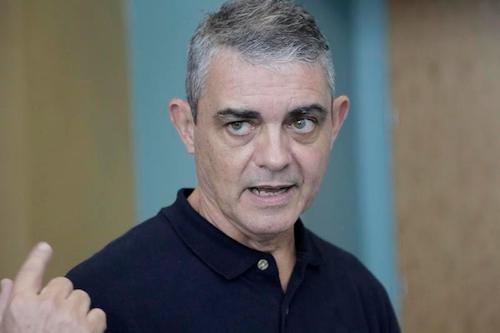
Miami Herald
Alejandro De La Campa
“That’s the key. Once the electrical service is restored we will be able to begin to move forward. We will be able to stop bringing so much water, so much food,” he said.
For several days, prior to María’s arrival, Rosselló — following FEMA’s recommendation to all North Americans who are exposed to hurricanes — alerted citizens to prepare for 72 hours of self-sufficiency.
“There will be no electricity when this happens,” he said, anticipating a “general communications collapse.” “It is possible that we will have a significant amount of time, at least three or four days, in a blackout.”
Try five. Six. Seven . It was many more.
Anticipating the ravage that María could cause, the Governor ordered the opening of 500 shelters. The day before the hurricane there were only about 300 evacuees in the shelters, but once the phenomenon passed and the rains continued, that number grew to 15,000.
Hurricane María was not done doing damage when governor Rosselló already knew, by the force of the winds he felt from La Fortaleza, the level of devastation he would see as he walked out the door.
The cyclone was still in Corozal when the executive began making landline calls to take care of what he could. The first call was to the White House to request a major disaster declaration for the first 54 municipalities struck. President Donald Trump approved it that same day.
What Rosselló was unaware of was the chain of disasters that would occur in the next 72 hours, and then practically every day for a month.
The first problem for a rapid response was for key figures to reach the Alternate Emergency Operations Center at the Miramar Convention Center because the original one, located in Caguas, collapsed due to flooding. The Secretary of Public Safety and official in charge of all Puerto Rican agencies responding to the emergency, Héctor Pesquera, had to leave his house on foot, briefcase in hand and flashlight in his mouth, because his street was completely blocked by trees. The only call he could make before he lost the signal was to a policeman who was able to pick him up on the main road.
Ricardo Ramos, executive director of the Puerto Rico Electric Power Authority (PREPA), spent the hurricane at the public corporation’s headquarters in Miramar watching on the monitors how the entire island lost power until the phenomenon knocked down PREPA’s servers, leaving the man in charge of keeping the lights on, in the dark.
“Our emergency generator failed. Our technical offices lost their computers and flooded. The offices are now full of mice,” he said.
A PREPA plant in Arecibo, near where María’s eye exited the island, experienced so much flooding that employees had to climb up the chimney to save themselves. The lack of communication after the storm was of such magnitude that Ramos had to fly over PREPA’s destroyed offices and plants facilities throughout Puerto Rico, to see if his employees were OK.
In San Juan, that morning Rosselló would make his first reconnaissance flight over the island, but when Puerto Rico National Guard Assistant General Isabelo Rivera went to look for the helicopter for the tour, the aircraft had been destroyed, as well as the two main facilities of the military corps in Puerto Rico: its headquarters in Puerta de Tierra and Camp Santiago in Salinas. National Guard (NG) pilots, the only military presence in the first 48 hours after the emergency, embarked on a road trip through the blocked roads to Puerto Rico’s western end to search for the alternate helicopter that was in Aguadilla. Governor Rosselló was finally able to fly over Puerto Rico and see the magnitude of the disaster. It was Thursday, 2 p.m.
Nine hours later, a call from Washington and a call from a journalist alerted Rosselló about extreme flooding in Toa Baja caused by the opening of the floodgates of the La Plata reservoir, which prompted him to spend Friday night and Saturday morning on an operation to rescue 2,000 people, many of whom waited on the roofs of their homes. Eight people died. There were no alarms that should have alerted the population, Mayor Bernardo “Betito” Márquez denounced.
The next day, Rosselló had to move northwest to see the break in the Guajataca dam. A few days later, the media reported on the crisis caused by the lack of electricity in the island’s 69 hospitals, where an undetermined number died due to a lack of oxygen, dialysis and other essential services. Chaos ensued over a lack of fuel and a backlog of goods at the ports.
“What’s important for me is to make them (in the United States) understand is that this is a dynamic situation, which if left unattended could put us back in the same situation, or worse,” Rosselló said during an interview about the emergencies that continued to surface daily after María struck.
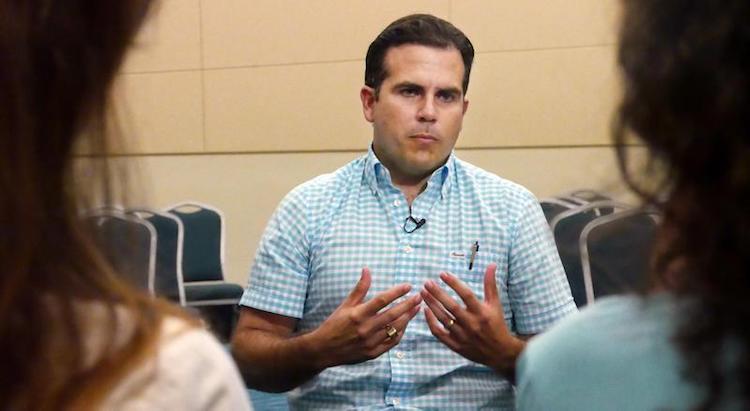
Miami Herald
Governor Ricardo Rosselló
Most of Puerto Rico’s 78 mayors have been critical of both the central and the federal governments.
Immediate Response
To a large extent, the immediate response focused on saving lives. FEMA activated 16 urban search and rescue teams. Pesquera deployed cops, firefighters and paramedics to the towns as word-of-mouth anecdotes reached him about flash floods, landslides and damages. Cataño. Toa Baja. Canóvanas. No one in the government had an overarching idea of how bad things were. Before requesting federal aid, Puerto Rico depends on municipal governments to report damages. But most mayors only had walkie-talkies and old satellite phones, which could barely generate calls, to communicate.
“I was surprised that they weren’t able to marshal the resources needed quicker to address the problem. I thought it was an inadequate response,” said P.K. “Ken” Keen, the retired three-star general who commanded the U.S. military response to the 2010 Haiti earthquake.
The lack of communication may have been partly to blame for what happened. In Haiti, “the cell towers did not get destroyed in the earthquake, which was fortunate. We didn’t lose our power to the extent that it happened in Puerto Rico, and the cell towers came back up that night. So were able to start using our cell phones, which were really our primary means of communications.”
Commercial airlines could not fly because the Federal Aviation Administration had not cleared the space for air traffic.
De La Campa, who spent three days living in the FEMA warehouse in Caguas and didn’t make it to his own home and family for five days, said he realized just how bad María was only after the storm: He stepped outside once its worst winds subsided and saw concrete power poles — the sturdiest ones of them all — lying flat on the main roads leading into San Juan.
“That’s when you realize how catastrophic the event was,” he said.
Some, like the mayor of Maunabo, categorized the disaster response as another “disaster.” FEMA’s help in terms of food and water began arriving with the military two weeks ago, but delivery of tarps has been slow and inadequate and residents and businesses have continued to add to the Sept. 20 losses every time it rains
The roads are clear thanks to the dedication and inventive of the town’s 400 municipal employees and contractors, and residents, as well as the equipment he got loaned even though he can’t pay for it with the town’s crippled municipal finances. Márquez is confident that FEMA will pay the bill, based on his experience with previous disasters. This situation was replicated throughout Puerto Rico, as citizens and public employees of the local first response agencies took to the streets to break through.
Although Trump authorized the disaster declaration immediately so FEMA could start disbursing funds, the reimbursement system and its requirement that such instrumentalities contribute 25 percent of the costs, made this assistance virtually inoperative given the Puerto Rico government’s lack of cash on hand. It took six more days after the president signed the authorization to eliminate the 25% matching requirement for funds to start flowing.
This initial declaration was only for its so-called categories A and B, which refer to emergency aid and debris removal for agencies and municipalities throughout Puerto Rico. Assistance to affected individuals was only approved for the initial 54 municipalities, and it was not until 12 days later that FEMA Administrator Brock Long approved the amendment to include the remaining 24 municipalities, according to the tract of the documents that the federal agency maintains online.
Categories C to G, which include reconstruction funds, have not yet been approved for Puerto Rico.
FEMA wasn’t ready for the magnitude of the disaster. It only had 20,000 tarps in Puerto Rico, as well as 500,000 meals and 700,000 liters of water — the amount of supplies it usually stores. Those supplies proved insufficient for a population of 3.4 million that was totally affected by the loss of 100% of power and communications systems and 80% of the drinking water system.
Meals and water ran out in two days; the tarps immediately, De La Campa admitted.
The Puerto Rican government estimated to FEMA that 250,000 homes were severely affected by María, and a month later, only 40,000 tarps have been distributed. That is, only 16% of the need has been met in this segment, and partially, because the tarps delivered measure 20×25 feet and cannot cover an entire roof. The explanation given by FEMA is that tarp reserves in the U.S. were depleted by hurricanes Harvey and Irma, and the manufacturers had no more product available.
The reinforced sheeting, part of the so-called Operation Blue Roof, which covers the entire roof, is available. But after a month, just 439 of the 4,245 tarps authorized by the United States Army Corps of Engineers — or 10 percent of the number the federal government recognizes as necessary, according to FEMA. The federal emergency agency was unable to provide a number for how many Blue Roof applications it has received so far.
In this case, the reason for the delay cited by both FEMA and the Government of Puerto Rico is that the Corps of Engineers must install them and they lack the personnel needed to go at a faster pace.
De La Campa anticipated that next week he would be receiving 500,000 tarps to be able to deal with the need expressed by the government and the mayors, and keep the warehouse stocked.
In the area of food and water, after the initial shortage of supplies, by the third week FEMA had distributed 10.5 million meals and 10 million liters of water, the agency reported.
In total, FEMA has presently disbursed $430 million in aid to agencies, municipalities and individuals, $270 million of that to PREPA and the Aqueduct and Sewer Authority.
The estimated costs of damages María caused Puerto Rico fluctuate between $20 billion and $95 billion. This last figure was offered by the governor and includes the loss of economic productivity.
Much remains to be learned about the flaws in emergency response and recovery related to the historic hurricane, the disaster that has required the largest distribution of FEMA food and water in U.S. history. But some of the people responsible for the process already recognize that they will have to review and change their response plans.
De La Campa, who until Oct. 10 was FEMA’s Federal Coordinating Officer (FCO), will recommend doubling the amount of supplies FEMA has in its warehouses in Puerto Rico to have reserves for one week.
“We’ll have to re-think many of the actions we’ve taken,” he admitted.
Puerto Rico’s Achilles’ heel: Electrical Power
María surprised PREPA in its worst place in history: with decades of lack of maintenance, no cash flow, with less than half of its usual 3,500 technical employees on payroll, and with a lawsuit by its bondholders looming. Ramos knew he was going to need help to restore power, so before María made landfall, he requested emergency proposals.
Two companies responded, but one, which Ramos declined to name, demanded a $25 million payment guarantee up front. The other, a small and inexperienced Wisconsin-based company, Whitefish Energy Holdings, did not place that requirement. Ramos said that is why Whitefish was contracted for what would be the monumental task of restoring Puerto Rico’s power service after María.
PREPA did not seek help from the American Public Power Association, a recognized entity of mutual aid among states in the area of electrical infrastructure, despite the fact that other utilities would have been willing to come and help, because he would have had to negotiate financial agreements with them. The New York Electric Power Authority sent its brigades based on a direct request to the state for aid.
“The Authority does not have the liquidity to cover all of the expenses,” said Ramos. “I have to pay them and then ask for a refund. It’s a cash flow problem.”
Whitefish, in turn, has subcontracted other local and stateside entities for the job. Among them are JEA from Jacksonville and the Kissimmee Utility Authority.
Ramos also gave the green light to 32 of his contractors to work for Whitefish, and has its own equipment available to help the company if requested.
When Irma hit Florida, it left 60% of its 6.7 million customers without power, but 10 days later, 98% had their service restored. In Puerto Rico, 30 days later, there are still 82% of Puerto Ricans without this essential service.
The deteriorating and outdated state of Puerto Rico’s electrical infrastructure is well known as well as the outages that occur in the system when hurricanes pass through the island. When Irma combed northeastern Puerto Rico, two weeks before Maria’s arrival, 70% of clients lost service, and in 15 days 97% had recovered it.
However, María’s fury devastated the deteriorated system, entirely. Ramos said PREPA’s newest equipment is from the 1970s, and many of it is from the 60s and 50s. The useful life of this equipment is assumed to be 30 years. In addition, since 2014 the public corporation has lost 2,100 of its technical employees who have resigned accepting better employment opportunities in the face of austerity measures implemented by the government. The exodus left them with only 1,393 employee brigades to tend to the monumental emergency.
Faced with this picture and María’s anticipated devastation, PREPA also recruited 60 local contractors, but they did not have enough line workers or trucks, nor did they have the resources to maintain brigades coming from abroad to help. The government did not have gas, food or lodging to give them.
The Puerto Rico National Guard has its soldiers to assist but, according to General Rivera, PREPA does not have enough poles available. Now the agency expects a shipment with the 60,000 posts it needs for reconstruction, Ramos said.

Abimael Medina | Centro de Periodismo Investigativo
Punta Diamante in Ponce, Puerto Rico
Complex chain of command in the emergency
The emergency response plans by the United States and Puerto Rico put the state governor — in this case, the territorial governor — as the person in charge and responsible for the entire response in a sort of triumvirate with two additional positions that are activated: a “state coordinating officer” and a “federal coordinating officer.”
The first position, officially occupied by the executive director of the State Emergency Management and Disaster Assistance Agency, Abner Gómez, but de facto occupied by Secretary Pesquera, is the person in charge of serving to communicate all the requests of Governor Rosselló to FEMA. The second, initially by De La Campa, and then by Mike Byrne, who led the recovery in Texas after Hurricane Harvey, is channeling petitions for final approval to FEMA’s manager, Long, and then coordinating the work with all federal agencies and military bodies activated for the emergency.
The President has to make the largest requests for funds for response and reconstruction to Congress and approved by that body.
In the case of the militia, the complex network establishes on paper that the official in charge is the Assistant General of the National Guard, in this case Rivera, who responds directly to the Governor, given that it is a civil effort, not a war effort. Under his command, the figure of the Dual Status Commander that oversees the performance of all branches of the Army, including the active soldiers is activated. Rivera responds directly to Rosselló. However, in practice, the matter becomes confusing and academic, since FEMA, not the governor, is the one who directly asks the designated Army representative what they want. On the other hand, it is the Northern Command, under the command of the U.S. Secretary of Defense, which officially issues the military work order and who has the authority to supervise the work of active military personnel.
The military effort was initially under the jurisdiction of Navy and Admiral Jeff Hughes, who was already in charge since Irma because the Northern Command decided that the response to the phenomenon in the islands, Puerto Rico and Virgin Islands, would be by sea as forces had been stationed in Florida.
Whether Washington was aware or not of the total devastation María caused in Puerto Rico immediately after it struck remains a mystery. Federal sources said the White House was directly involved in the response, but Trump spent that weekend playing golf in New Jersey and tweeting about the protest by National Football League players, diverting attention from the grave situation, which the incommunicated island was experiencing.
It was not until Sept. 25 that Long and National Security Department advisor Tom Bossert sounded the alarm in Washington after visiting and flying the ravages in Puerto Rico. It was then when they began to have receptivity, privately, to the criticisms of the territory’s leaders on the slowness of the response.
In public, Rosselló predicted that if Puerto Rico did not act quickly it would have “a humanitarian crisis” that would lead to a massive exodus of Puerto Ricans to the United States. A month after María, the governor continues to repeat the same warning, and it is estimated that only 60,000 Puerto Ricans have arrived during the emergency.
“María was one mile per hour from being a Category 5 storm, but it’s the worst Puerto Rico has seen. It’s been very complex for us to respond, from a logistical nature of the island,” Long acknowledged at a news conference on his return to Washington.
Within seven days of María’s passage, changes in the leadership in charge of the response began. Some quietly, others with extensive media coverage. The first was on Sept. 27 when Northern Command Chief, General Lori Robinson, decided to put the Army, instead of the Navy, in charge of the military effort and appointed three-star lieutenant general Jeffrey Buchanan in command of the response. Buchanan was in California leading the emergency response caused by wildfires and arrived to Puerto Rico two days later.

Ten days after María, Gómez was officially replaced by Pesquera and disappeared from the public eye. Pesquera had been appointed from day one as Incident Commander in charge of ensuring that the 131 local government agencies implemented the Governor’s public policy related to the response. With both positions Pesquera became the Puerto Rico government’s most powerful man, after Rosselló.
Twenty days later, De La Campa was relieved of his position as FCO and replaced by Byrne. FEMA said the replacement responded to the “expansion” of its response-led team and freed De La Campa to continue his regular work as FEMA Director for the Caribbean in charge of local affairs in Puerto Rico and the U.S. Virgin Islands. De La Campa said in an interview that the change had been planned from the beginning of the event, and that the federal agency had asked him to temporarily fill the post.
Puerto Ricans, frustrated with the slow advances in the complex situation that is taking place, and some FEMA critics within the Rosselló administration, saw the change of command as an acceptance of the failures in the federal agency’s response.
On the same day that Long visited Puerto Rico, Florida Republican Sen. Marco Rubio — who advocated early for military assistance for the island — also visited.
“No governmental organization likes to admit that their needs outstrip their capacity,” Rubio told the Herald/CPI. “The (Puerto Rico) government itself became a victim of the storm, in many ways. … The logistical capacity of the government was compromised.”
Changes continued with Buchanan’s arrival. The Puerto Rico National Guard quietly replaced from his post as Dual Status Commander Lieutenant Colonel Narciso Cruz, who had efficiently coordinated military efforts since Irma, by Brig. Gen. José Reyes. The change was triggered by issues related to star ranking in the militia, so with a senior officer, the Puerto Rican military could have effective communication with the new three-star general, Deputy General Rivera said.
Buchanan, who was in charge of the military response to hurricanes Harvey in Texas and Irma in Florida has extensive experience in international disaster scenarios, said: “This is the worst thing I’ve ever seen.”
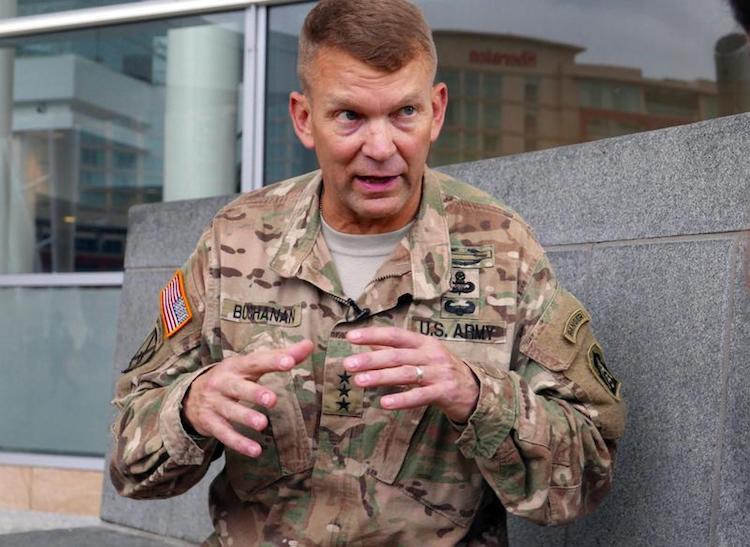
Miami Herald
Jeffrey Buchanan
He said although he was aware of the high level of devastation he would find, he did not expect to find the critical situation in the island’s hospitals because they depended on diesel power plants. In the mainland states, large hospitals usually work with thermoelectric plants during outages, which give them stability.
Meanwhile, President Trump was still tweeting phrases that belittled the gravity of Puerto Rico’s situation, implying that the chaos on the island was the fault of “lazy” Puerto Ricans — the same ones who have been clearing roads with electric saws and machetes.
“They want everything to be done for them when it should be a community effort. 10,000 workers are now on the island doing a fantastic job,” he tweeted on Sept. 30.
The President finally visited Puerto Rico on Oct. 3 for four hours, instead of the five hours originally announced, but continued to minimize the situation indicating that Hurricane María was not a “real catastrophe” like Hurricane Katrina in New Orleans was while cheerfully throwing rolls of paper towels at a group of refugees who received him in Guaynabo.
Two weeks later, Trump said in a news conference with Rosselló in Washington that María had been worse than Katrina.
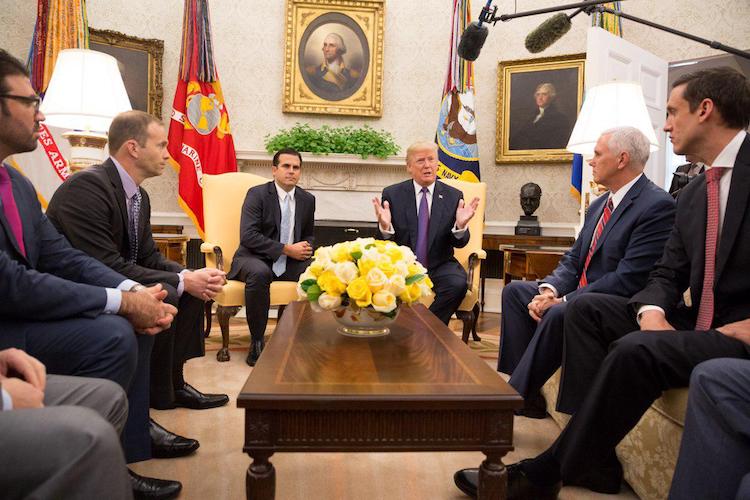
Buchanan accepted in a looking-back interview with the CPI/Herald a degree of validity in the criticism of the response to María.
“If you are here waiting for help, you are not patient,” he said. “And you shouldn’t be patient.”
However, he defended himself from critics who have argued that the Army, not the Navy, should have taken control of the operation earlier in the process.
“You don’t know what will happen with a storm until after it passes, so we were prepared, we had everything ready to take action, we had the right resources,” he said. “But after, María’s devastation was such that we knew it would require a lot from the military to be able to help.”
Two weeks after his appointment, the number of troops deployed to Puerto Rico increased from 4,100 to 13,400, and last week reached Buchanan’s projected peak of 14,500.
The number of helicopters tripled from the initial 25 to 72. The Navy brought the USNS Comfort hospital ship and the Army brought three fully self-sufficient military hospitals it established in Aguadilla, Caguas, and Humacao.
Buchanan was placed in charge of the military response on shore – but not the entire military response, a distinction criticized by retired Army Lt. Gen. Russel Honoré, who took over the Joint Task Force for Hurricane Katrina in New Orleans after poor performances by FEMA and the state and local governments.
In Puerto Rico, “the mission was scaled too small,” Honoré said in an interview for this story. “If people start dying, who the hell is going to be at fault?”
The 14,500 emergency-activated troops cited by Buchanan include the 4,500 Puerto Rico National Guard members that were available to be activated for the emergency. The remaining 2,500 are employed by first response agencies and it was decided to leave them in these functions, and soldiers who have migrated to the United States to the unemployment prevailing on the island. Even the Puerto Rican National Guards available took a week to fully report because many lost their residences in the storm or could not reach the base because the roads were still cut off.
“María treated us all the same,” General Rivera said. “Returning to the status where we were before the storm is going to take more than six months,” added the head of the Puerto Rico National Guard.
That’s how long Rosselló and Ramos initially estimated that it would take to restore 100% of Puerto Rico’s electric power. However, under fire from citizens and entrepreneurs desperate over the situation, on Oct. 14 Rosselló said the estimate was unacceptable and committed to a more aggressive agenda: 95% of customers with power on Dec. 15.
Although the announcement appeared to reflect Rossello’s annoyance and disagreement with the work being done by the PREPA chief to reestablish the electrical system, Ramos said in an interview that the announcement had been pre-agreed to at a meeting the prior day with Rosselló, who assured him that he would finally have the resources to accelerate the process.
The announcement also came after FEMA agreed to make an exception to the reimbursement system and advanced PREPA $128 million for emergency work. The federal agency had already given the public corporation $213 million under the reimbursement system.
“That help is very welcome because of the liquidity issue,” Ramos said.
Nevertheless, it was not enough and PREPA, waiting for a major contract that the U.S. Corps of Engineers would grant for the system’s reconstruction, decided to bring contractor Power Secure to speed up the work.
“The Corps of Engineers has a slow process,” he said.
De La Campa excused the delay by pointing out that FEMA needs to thoroughly justify requests for funds before U.S. taxpayers prior to authorizing disbursements of such magnitude.
“We’re talking a lot of money. There also has to be fiscal responsibility on the part of our agency,” he said.
On Monday, Oct. 16, 26 days after the storm, PREPA’s $100 million emergency fund had already run out and Ramos did not know how much, or when, money would start flowing again into the public corporation’s coffers.
When asked about how María would affect the restructuring plan PREPA submitted to the Fiscal Control Board and the court in the lawsuit with bondholders, he didn’t think about the response for a second.
“I don’t know anything about the bondholders. We’ll handle the bondholders when everything is back to normal. María has destroyed our infrastructure. We don’t have the funds to do what we would like to do,” Ramos said.
All the immediate threats that remain over the Puerto Rican population even at this time have their root cause in the lack of electrical energy throughout the island. With no electricity available in half of the hospitals, hundreds of patients are at risk every day. Without electricity, most of the drinking water plants do not work, and citizens are forced to drink water from contaminated springs or sources, causing potential health epidemics such as leptospirosis, which has already claimed four lives according to official sources. Without power, the bodies of people who continue to die of natural or emergency-related situations cannot even be properly disposed of.
Meanwhile the majority of Puerto Ricans, like the “maunabeños,” continue putting out fires like they did the first day.
At Maunabo’s Emergency Operations Center, 20 to 25 people are cared for daily in an improvised emergency room, while in front, the owner of the town’s funeral home set up a temporary room to view the dead in a vacant building.
“WE’RE OPEN,” reads a recently printed sign.
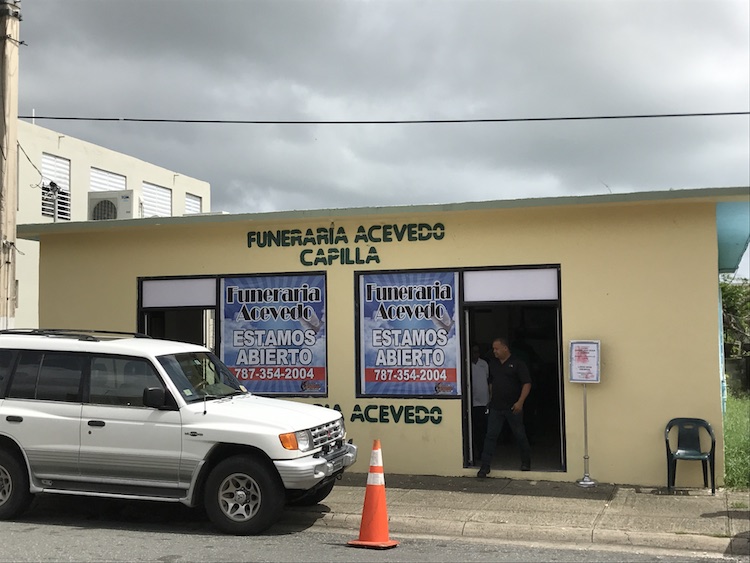
In the sports complex, turned into a collection center, soldiers still deliver water and food they bring from their distribution center in Ceiba. Employees and volunteers begin distribution to hundreds of residents of Maunabo and neighboring towns. Everything usually runs out by noon. Food is scarce and goes first — last Tuesday, they were out by 10. a.m.
“People ask for bread. And for baby formula. And for adult diapers,” said Deputy Mayor Luis Lafuente, pointing out that he often does not have any to give them.
He said those are the most sought-after articles at the scarcest to arrive at the moment.
On day 30, there were still 113 people missing in Puerto Rico, 48 official emergency-related deaths and possibly hundreds still unaccounted for, the population without electricity fell to 89%, and the power plant at the Río Piedras Medical Center, the North American colony’s main hospital, had failed.
“We’re operating with flashlight. This is unacceptable. The situation is getting out of control,” a resident doctor said Friday in a video posted on social networks.
Puerto Rico was still in emergency mode.


